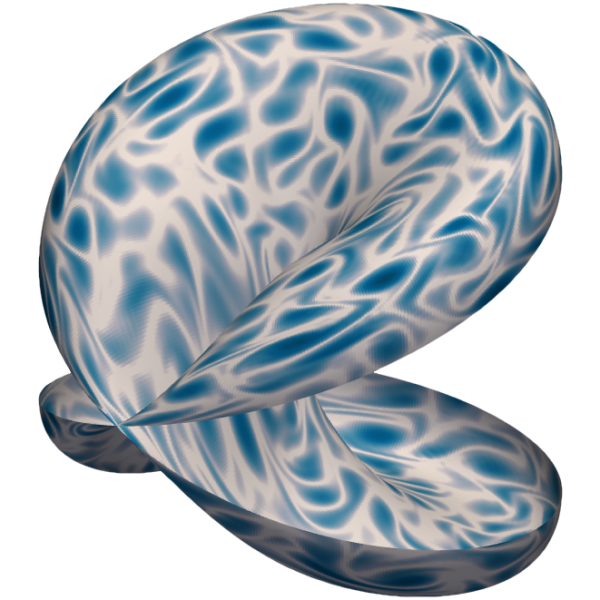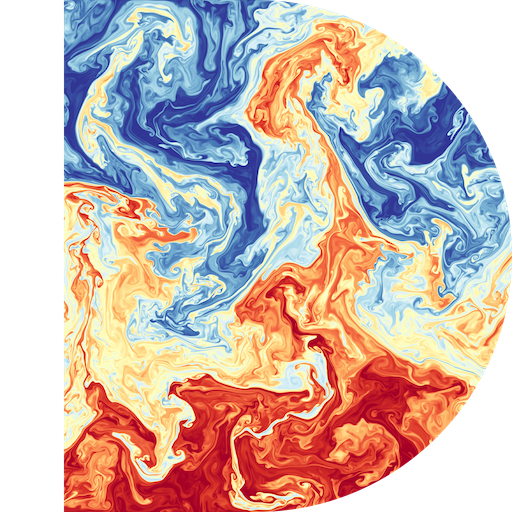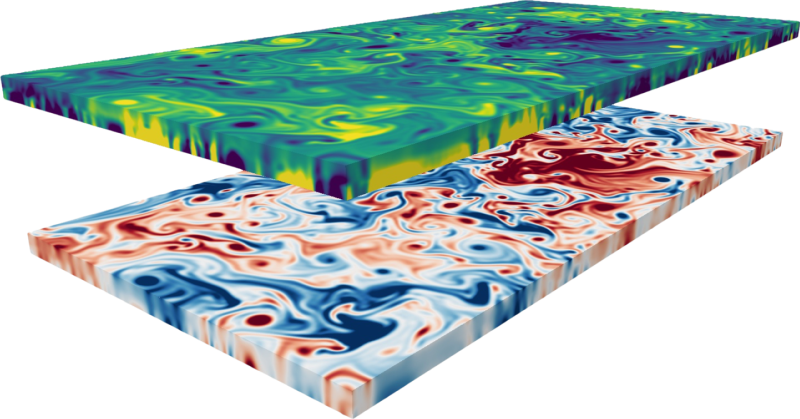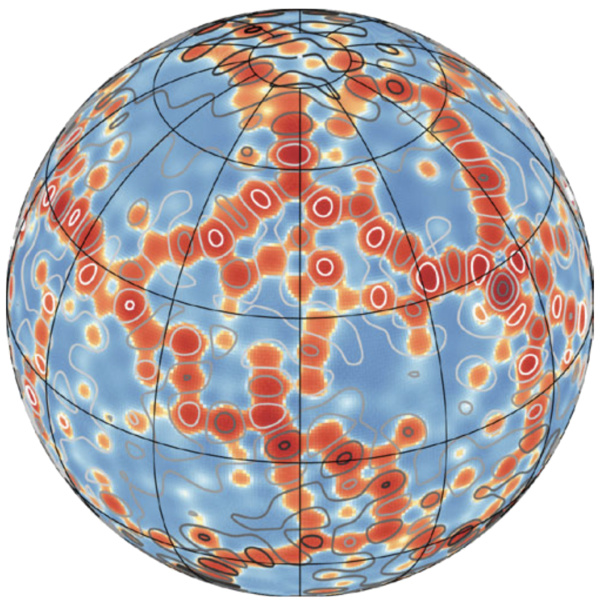I'm an applied mathematician working on numerical methods and scientific computing. I develop the Dedalus PDE solver and use it to study astrophysical, geophysical, and biological fluid dynamics.

Recent News
- Mar. 2025: I have started as a Principal Research Scientist in the math department at MIT.
- May 2024: Vasil et al. (2024) has been published in Nature and made the cover.
- Mar. 2024: I have been selected to receive an SSRF Award from the Simons Foundation.
- Mar. 2024: Romeo et al. (2024) has been published in JFM.
- Sep. 2023: Jackson et al. (2023) has been published in Nature Physics and made the cover.
- Jul. 2023: Anders et al. (2023) has been published in Nature Astronomy.
Research Areas

Modern spectral methods for PDEs
Spectral methods are a technique for discretizing PDEs that produce extremely accurate results in simple geometries. My work focuses on developing fast and flexible spectral solvers for large-scale scientific applications. My work in this area includes:
- Sparse tensorial bases for curvilinear coordinates.
- Generalized tau methods for enforcing boundary conditions.
- Fast direct solvers for coupled differential-algebraic systems.
- High-order immersed boundary and domain remapping techniques.
- Coupling to other PDE and BIE solvers.
Collaborators:
Ben Brown,
Dan Fortunato,
Eric Hester,
Daniel Lecoanet,
Jeff Oishi,
Geoff Vasil
References:
Burns et al. (2022),
Hester et al. (2021),
Hester et al. (2020),
Burns et al. (2020),
Burns et al. (2019),
Lecoanet et al. (2019),
Vasil et al. (2019),
Vasil et al. (2016)

Dedalus PDE solver
I'm the lead developer of Dedalus, an open-source framework for solving partial differential equations with modern spectral methods. Dedalus uses symbolic model specification to produce spectrally accurate, optimally sparse, and automatically parallelized solvers for broad ranges of custom equation sets on simple domains. It's written in Python and is easy to use on a laptop, yet calls compiled libraries for performance-critical routines and scales to thousands of cores with MPI.
Collaborators:
Ben Brown,
Daniel Lecoanet,
Jeff Oishi,
Geoff Vasil
References:
Oishi et al. (2021),
Burns et al. (2020),
Oishi et al. (2018),
Lecoanet et al. (2016)

Geophysical & astrophysical fluid dynamics
I have used Dedalus and other numerical tools to study broad ranges of geophysical and astrophysical fluid flows. This work has primarily focused on stellar and planetary waves, turbulence, and dynamos. I am also interested in cryospheric processes including ice-ocean interactions and the dynamics of icy moons.
Collaborators:
Santiago Benavides,
Ben Brown,
Glenn Flierl,
Eric Hester,
Daniel Lecoanet,
Jeff Oishi,
Geoff Vasil,
Nevin Weinberg,
Andrew Wells
References:
Oishi et al. (2022),
Benavides et al. (2022),
Benavides et al. (2021),
Hester et al. (2020),
Brown et al. (2020),
Oishi et al. (2020),
Lecoanet et al. (2019),
Burns (2018),
Lecoanet et al. (2016),
Lecoanet et al. (2016),
Lecoanet et al. (2015)

Complex flows: biological & quantum fluids
The flexibility of Dedalus makes it a powerful tool for simulating complex fluids, including models of biological and quantum systems. Such models can often be simulated at scales which allow for direct comparisons with laboratory data. My collaborators and I are currently using Dedalus to study various models of biophysical processes and active matter. In the quantum domain, I have recently studied wavepacket scattering and supersolid crystals.
Collaborators:
Jörn Dunkel,
Vili Heinonen,
Jonasz Słomka,
Nico Romeo
References:
Jackson et al. (2023),
Heinonen et al. (2022),
Supekar et al. (2020),
Heinonen et al. (2019),
Mickelin et al. (2018)
Recent Teaching
CISM Advanced Course: Fluid Mechancis of Planets and Stars
This week-long course covers the fundamentals of geophysical and astrophysical fluid, including lectures on turbulence, planetary interiors, stellar interiors, atmospheric flows, and magnetohydrodynamics. I was invited to provide 5 practical sessions on numerical simulations using Dedalus with a range of relevant examples. See the CISM course page and the Dedalus material on GitHub.
MIT 18.336J/6.7340J: Fast Methods for Partial Differential and Integral Equations
18.336 is a graduate course, cross-listed between math and computer science, covering preconditioned finite difference methods, Fourier and polynomial spectral methods, and low-rank methods for PDEs and integral equations. See the course page on GitHub.
MIT 18.031: System Functions and the Laplace Transform
18.031 is an undergraduate course covering continuous control theory and representations of functions in the complex frequency domain. Includes generalized functions, unit impulse responses, convolutions, Laplace transforms, system/transfer functions, and pole diagrams. Includes examples from mechanical and electrical engineering.
Publications
Preprints
-
High-level, high-resolution ocean modeling at all scales with Oceananigans
G. L. Wagner et al., arXiv preprint 2502.14148, [arXiv] -
Rapidly Rotating Wall-Mode Convection
G. M. Vasil et al., arXiv preprint 2409.20541, [arXiv] -
CATKE: a turbulent-kinetic-energy-based parameterization for ocean microturbulence with dynamic convective adjustment
G. L. Wagner et al., arXiv preprint 2306.13204, [arXiv] -
Corner Cases of the Generalized Tau Method
K. J. Burns et al., arXiv preprint 2211.17259, [arXiv] -
Emergent universal statistics in nonequilibrium systems with dynamical scale selection
V. Heinonen et al., arXiv preprint 2205.01627, [arXiv]
Journal articles & preprints
-
Multiple scales analysis of a nonlinear timestepping instability in simulations of solitons
B. A. Hyatt et al., Journal of Computational Physics, vol. 531, p. 113923, 15 Jun 2025. [doi] -
The solar dynamo begins near the surface
G. M. Vasil et al., Nature, vol. 629, pp. 769-772, 22 May 2024. [doi] -
Iterative Methods for Navier-Stokes Inverse Problems
L. O'Connor et al., Physical Review E, vol. 109, no. 4, p. 045108, 30 Apr 2024. [doi] -
Vortex line entanglement in active Beltrami flows
N. Romeo et al., Journal of Fluid Mechanics, vol. 982, 1 Mar 2024. [doi] -
Scaling behaviour and control of nuclear wrinkling
J. A. Jackson et al., Nature Physics, vol. 19, pp. 1927-1935, 18 Sep 2023. [doi] -
The photometric variability of massive stars due to gravity waves excited by core convection
E. H. Anders et al., Nature Astronomy, vol. 7, pp. 1228-1234, 27 Jul 2023. [doi] -
Fluid models capturing Farley-Buneman instabilities
E. L. Rojas et al., Annales Geophysicae, vol. 41, no. 2, pp. 281-287, 13 Jul 2023. [doi] -
Effective Drag in Rotating, Poorly Conducting Plasma Turbulence
S. J. Benavides et al., The Astrophysical Journal, vol. 938, no. 2, p. 92, 17 Oct 2022. [doi] -
The stability of Prendergast magnetic fields
E. Kaufman et al., MNRAS, vol. 517, no. 3, pp. 3332-3340, 4 Oct 2022. [doi] -
Direct statistical simulation of the Busse annulus
J. S. Oishi et al., Journal of Fluid Mechanics, vol. 949, 3 Oct 2022. [doi] -
Transport and emergent stratification in the equilibrated Eady model: the vortex-gas scaling regime
B. Gallet et al., Journal of Fluid Mechanics, vol. 948, 12 Sep 2022. [doi] -
Inverse cascade suppression and shear-layer formation in magnetohydrodynamic turbulence subject to a guide field and misaligned rotation
S. J. Benavides et al., Journal of Fluid Mechanics, vol. 935, 25 Jan 2022. [doi] -
eigentools: A Python package for studying differential eigenvalue problems with an emphasis on robustness
J. Oishi et al., Journal of Open Source Software, vol. 6, no. 62, p. 3079, 23 Jun 2021. [doi] -
Improving accuracy of volume penalised fluid-solid interactions
E. W. Hester et al., Journal of Computational Physics, vol. 430, p. 110043, 1 Apr 2021. [doi] -
Improved phase-field models of melting and dissolution in multi-component flows
E. W. Hester et al., Proceedings of the Royal Society A, vol. 476, no. 2242, 21 Oct 2020. [doi] -
Single-hemisphere Dynamos in M-dwarf Stars
B. P. Brown et al., The Astrophysical Journal Letters, vol. 902, no. 1, p. L3, 7 Oct 2020. [doi] -
Dedalus: A flexible framework for numerical simulations with spectral methods
K. J. Burns et al., Physical Review Research, vol. 2, no. 2, 23 Apr 2020. [doi] -
Linearly forced fluid flow on a rotating sphere
R. Supekar et al., Journal of Fluid Mechanics, vol. 892, 6 Apr 2020. [doi] -
The magnetorotational instability prefers three dimensions
J. S. Oishi et al., Proceedings of the Royal Society A, vol. 476, no. 2233, p. 20190622, 8 Jan 2020. [doi] -
Low-frequency Variability in Massive Stars: Core Generation or Surface Phenomenon?
D. Lecoanet et al., The Astrophysical Journal, vol. 886, no. 1, p. L15, 18 Nov 2019. [doi] -
Quantum hydrodynamics for supersolid crystals and quasicrystals
V. Heinonen et al., Physical Review A, vol. 99, no. 6, 24 Jun 2019. [doi] -
Tensor calculus in spherical coordinates using Jacobi polynomials. Part-II: Implementation and examples
D. Lecoanet et al., Journal of Computational Physics: X, vol. 3, p. 100012, 1 Jun 2019. [doi] -
Tensor calculus in spherical coordinates using Jacobi polynomials. Part-I: Mathematical analysis and derivations
G. M. Vasil et al., Journal of Computational Physics: X, vol. 3, p. 100013, 1 Jun 2019. [doi] -
Anomalous Chained Turbulence in Actively Driven Flows on Spheres
O. Mickelin et al., Physical Review Letters, vol. 120, no. 16, 20 Apr 2018. [doi] -
Rolling resistance of shallow granular deformation
K. J. Burns et al., Proceedings of the Royal Society A, vol. 473, no. 2207, p. 20170375, 29 Nov 2017. [doi] -
Conversion of internal gravity waves into magnetic waves
D. Lecoanet et al., MNRAS, vol. 466, no. 2, pp. 2181-2193, 15 Dec 2016. [doi] -
Turbulent Chemical Diffusion in Convectively Bounded Carbon Flames
D. Lecoanet et al., The Astrophysical Journal, vol. 832, no. 1, p. 71, 18 Nov 2016. [doi] -
Tensor calculus in polar coordinates using Jacobi polynomials
G. M. Vasil et al., Journal of Computational Physics, vol. 325, pp. 53-73, 15 Nov 2016. [doi] -
A validated non-linear Kelvin-Helmholtz benchmark for numerical hydrodynamics
D. Lecoanet et al., MNRAS, vol. 455, no. 4, pp. 4274-4288, 7 Dec 2015. [doi] -
Numerical simulations of internal wave generation by convection in water
D. Lecoanet et al., Physical Review E, vol. 91, no. 6, 30 Jun 2015. [doi] -
Conduction in Low Mach Number Flows. I. Linear and Weakly Nonlinear Regimes
D. Lecoanet et al., The Astrophysical Journal, vol. 797, no. 2, p. 94, 3 Dec 2014. [doi] -
FIRST, a fibered aperture masking instrument
E. Huby et al., Astronomy & Astrophysics, vol. 541, p. A55, 27 Apr 2012. [doi]
Whitepapers & theses
-
The Puzzling Structure of Solar Convection: Window into the Dynamo
N. A. Featherstone et al., arXiv preprint 2305.08823, May 2023. [arXiv] -
Flexible Spectral Algorithms for Simulating Astrophysical and Geophysical Flows.
K. J. Burns, MIT Doctoral Thesis, Jun 2018. [pdf] -
Perspectives on Reproducibility and Sustainability of Open-Source Scientific Software from Seven Years of the Dedalus Project
J. S. Oishi et al., arXiv preprint 1801.08200, Jan 2018. [arXiv] -
Chebyshev Spectral Methods with Applications to Astrophysical Fluid Dynamics.
K. J. Burns, Cambridge Part III Essay, May 2013. [pdf] -
Tidal Effects in Binary Star Systems.
K. J. Burns, UC Berkeley Senior Thesis, Jun 2012.